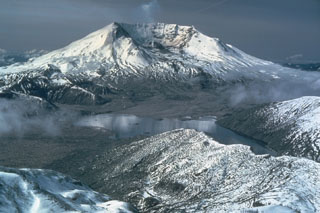Report on St. Helens (United States) — April 1983
Scientific Event Alert Network Bulletin, vol. 8, no. 4 (April 1983)
Managing Editor: Lindsay McClelland.
St. Helens (United States) Intrusive and extrusive dome growth continue
Please cite this report as:
Global Volcanism Program, 1983. Report on St. Helens (United States) (McClelland, L., ed.). Scientific Event Alert Network Bulletin, 8:4. Smithsonian Institution. https://doi.org/10.5479/si.GVP.SEAN198304-321050
St. Helens
United States
46.2°N, 122.18°W; summit elev. 2549 m
All times are local (unless otherwise noted)
Since early February, growth of the composite lava dome has been essentially continuous. Accelerating outward movement of the dome had preceded previous extrusion episodes, but stopped as lava reached the surface. However, substantial endogenous growth has continued throughout the current episode. Poor weather continued to hamper observations.
About 1 April, a broad stubby spine began to emerge at roughly 1 m/day from the center of the February lobe, reaching 30 m in N-S dimension, 20 m E-W, and about 25 m in height. Growth of this spine stopped about 15 April, and extrusion of another spine started about 70 m to the SE. The latter spine remained active until about 27 April, when at 60 m height it was the highest point on the dome and roughly the same size as the now-toppled February spine (SEAN 08:02). Between visits to the crater 29 April and 4 May a new lobe began to grow high on the NE flank of the February lobe. This lava had a typical "spreading center" source and scoriaceous carapace. Extrusion continued as of 11 May, but the growth rate was slow and the lobe remained several times smaller than previous ones.
Dramatic deformation has continued on the E and particularly the NE sector of the dome since early-mid March. Because of frequent rockfalls, it was difficult to maintain targets on these areas of the dome, but rates of displacement reached 1.5 m/day, and averaged about 1 m/day over roughly 1-week periods. Between measurements 4 and 11 May, the NE margin of the dome moved 9 m outward and 2.5 m downward. Deformation on the N side of the dome was limited, but significant rate changes were observed. Through March the rate was constant at about 1.5 cm/day, but dropped to about 1 cm/day around 1 April as spine growth started. Deformation slowed further to 7-8 mm/day around the 15th as growth of one spine stopped and extrusion of another began, but returned to about 1 cm/day at the end of the month and remained at that rate as of 11 May. The W side of the dome, site of the most rapid deformation before many previous extrusion episodes, remained quite stable. No significant deformation of the edifice as a whole was detected.
Vapor and tephra emissions continued from the main vent near the source area of the February lobe but were relatively infrequent, occurring one to three times per day. Blocks up to 30 cm in diameter were ejected. Tephra could often be seen in the plumes, which sometimes rose to 1 km above the crater rim; the largest, 18 April at 1259, reached 6 km altitude. There was no apparent correlation between plume emissions and changes in extrusive activity or deformation.
SO2 emission remained at roughly 150 t/d until about 27 April, when it dropped to 60-90 t/d. A similar rate was measured 30 April and 4 May, but SO2 emission returned to 150 t/d 11 May.
Seismic activity remained elevated through April. All but nine of the 243 events with locatable foci were of low-frequency with emergent onsets, a similar pattern to that seen in March. Between 1 and 12 April, daily earthquake totals commonly ranged from four to eight, increased to eight to twelve events per day 13-24 April, then dropped slightly to an average of eight per day through the end of the month. Surface and avalanche events showed a similar pattern. Numerous gas-emission events were recorded. Many began with a series of high-amplitude events that ended within a few minutes or gradually faded into brief periods of harmonic tremor. About 20 April, sequences of tiny discrete similar events, previously seen in February (SEAN 08:02), reappeared on one seismometer, but these events could not be located and their significance remained uncertain. The start of extrusion of a new lobe of lava between visits to the crater 29 April and 4 May was not marked by an obvious change in seismicity. Geologists working in the crater 11 May heard loud but relatively small earthquakes, which had not been audible during previous extrusion episodes.
Geological Summary. Prior to 1980, Mount St. Helens was a conical volcano sometimes known as the Fujisan of America. During the 1980 eruption the upper 400 m of the summit was removed by slope failure, leaving a 2 x 3.5 km breached crater now partially filled by a lava dome. There have been nine major eruptive periods beginning about 40-50,000 years ago, and it has been the most active volcano in the Cascade Range during the Holocene. Prior to 2,200 years ago, tephra, lava domes, and pyroclastic flows were erupted, forming the older edifice, but few lava flows extended beyond the base of the volcano. The modern edifice consists of basaltic as well as andesitic and dacitic products from summit and flank vents. Eruptions in the 19th century originated from the Goat Rocks area on the N flank, and were witnessed by early settlers.
Information Contacts: D. Swanson, T. Casadevall, USGS CVO, Vancouver, WA; S. Malone, University of Washington.

